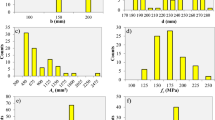Abstract
Artificial Intelligence (AI) technology has proved itself as a proficient substitute for classical techniques of modeling. AI is a branch of computer science with the help of which machines and software with intelligence similar to humans can be developed. Many problems related to structural as well as civil engineering are exaggerated with uncertainties that are difficult to be solved using traditional techniques. AI proves advantageous in solving these complex problems. Presently, a comprehensive model based on the convolutional neural network technique of artificial intelligence is developed. This model is advantageous in accurately predicting the structure of a bridge without the need for actual testing. The firefly algorithm is used as a technique for accurate feature selection. The database is taken from national bridge inventory (NBI) using internet sources. Different performance measures like accuracy, recall, precision, and F1 score are considered for accurate prediction of the bridge structure and also provide advantages in actual monitoring and controlling of bridges. The proposed CNN model is used to measure these parameters and to provide a comparison with the standard CNN model. The proposed model provides a considerable amount of accuracy (97.49%) as compared to accuracy value (85%) using the standard CNN model.







Similar content being viewed by others
References
Garlock, M., Paya-Zaforteza, I., Kodur, V., & Gu, L. (2012). Fire hazard in bridges: Review, assessment and repair strategies. Engineering Structures. https://doi.org/10.1016/j.engstruct.2011.11.002
Lewis, P. M. R., & Reynolds, K. (2002). Forensic engineering: A reappraisal of the Tay Bridge disaster. Interdisciplinary Science Reviews, 27, 287–298. https://doi.org/10.1179/030801802225005725
Billah, K. Y., & Scanlan, R. H. (1991). Resonance, Tacoma Narrows bridge failure, and undergraduate physics textbooks. American Journal of Physics, 59, 118–124. https://doi.org/10.1119/1.16590
Kodur, V. K., Aziz, E. M., & Naser, M. Z. (2017). Strategies for enhancing fire performance of steel bridges. Engineering Structures. https://doi.org/10.1016/j.engstruct.2016.10.040
Scheer, J. (2010). Failed bridges: Case studies, causes and consequences. Wiley.
ASCE (2017) ASCE infrastructure report card. https://www.infrastructurereportcard.org/cat-item/bridges/
Wang L, Yang L, Huang D, Zhang Z, GC.-I.-J. of undefined 2008. An impact dynamics analysis on a new crashworthy device against ship–bridge collision, Elsevier. https://www.sciencedirect.com/science/article/pii/S0734743X07001868.
Liu, M., & Frangopol, D. M. (2004). Optimal bridge maintenance planning based on probabilistic performance prediction. Engineering Structures. https://doi.org/10.1016/j.engstruct.2004.03.003
Robelin C, S.M.-J. of I. Systems, undefined 2007, History-dependent bridge deck maintenance and replacement optimization with Markov decision processes. Ascelibrary.Org. (n.d.).
Naser, M. Z., & Kodur, V. K. R. (2015). A probabilistic assessment for classification of bridges against fire hazard. Fire Safety Journal, 76, 65–73. https://doi.org/10.1016/j.firesaf.2015.06.001
Peris-Sayol, G., Paya-Zaforteza, I., Balasch-Parisi, S., & Alo´s-Moya, J. (2017). Detailed analysis of the causes of bridge fires and their associated damage levels. Journal of Performance of Constructed Facilities. https://doi.org/10.1061/(asce)cf.1943-5509.0000977
Kodur, V., Gu, L., & Garlock, M. E. M. (2010). Review and assessment of fire hazard in bridges. Transportation Research Record. https://doi.org/10.3141/2172-03
Cooper, J. D., Fiedland, I. M., Buckle, I. G., Nimis, R. B., & McMullin Bobb, N. (1994). The Northridge earthquake: Progress made, lessons learned in seismic-resistant bridge design. Public Roads, 58(1), 26–36.
Fujino, Y., & Yoshida, Y. (2002). Wind-induced vibration and control of trans-Tokyo bay crossing bridge. Journal of the Structural Engineering. American Society of Civil Engineers. https://doi.org/10.1061/(asce)0733-9445(2002)128:8(1012)
Aashto LRFD bridge design specifications, 8th edition (2017). https://store.transportation.org/item/collectiondetail/152.
Computational intelligence: A logical approach. Choice Rev Online 1998;35:35–5701–35–5701. doi: https://doi.org/10.5860/CHOICE.35-5701.
Kurzweil, R. (2000). The age of spiritual machines: When computers exceed human intelligence. Penguin Books.
Michalski, R. S., Carbonell, J. G., & Mitchell, T. M. (2013). Machine learning: An artificial intelligence approach. Springer.
Alpaydin, E. (2014). Introduction to machine learning. MIT Press.
Robert, C. (2014). Machine learning, a probabilistic perspective. CHANCE, 27(2), 62–63.
Marsland, S. (2015). Machine learning: An algorithmic perspective. CRC Press.
Kang, F., Liu, X., & Li, J. (2019). Concrete dam behavior prediction using multivariate adaptive regression splines with measured air temperature. Arabian Journal for Science and Engineering, 44, 8661–8673. https://doi.org/10.1007/s13369-019-04095-z
Mozumder, R. A., Roy, B., & Laskar, A. I. (2017). Support vector regression approach to predict the strength of FRP confined concrete. Arabian Journal for Science and Engineering, 42, 1129–1146. https://doi.org/10.1007/s13369-016-2340-y
Ciresan DC, Meier U, Masci J, Maria Gambardella L, Schmidhuber J. Flexible, high performance convolutional neural networks for image classification. vol. 22, Barcelona, Spain; 2011, p. 1237.
Kaur, A., Sharma, S., & Mishra, A. (2019). Performance optimization of cognitive decision engine for CR-based IoTs using various parameter-less meta-heuristic techniques. Arabian Journal for Science and Engineering, 44, 9499–9515. https://doi.org/10.1007/s13369-019-03787-w
Sindhu, R., Ngadiran, R., Yacob, Y. M., Zahri, N. A. H., & Hariharan, M. (2017). Sine–cosine algorithm for feature selection with elitism strategy and new updating mechanism. Neural Computing and Applications, 28(10), 2947–2958.
Yang, X.-S. (2013). Multiobjective firefly algorithm for continuous optimization. Engineering with Computers, 29(2), 175–184.
Al-Thanoon, N. A., Qasim, O. S., & Algamal, Z. Y. (2020). Variable selection in gamma regression model using binary gray wolf optimization algorithm. Journal of Physics: Conference Series, 1591, 012036.
Qasim, O. S., Al-Thanoon, N. A., & Algamal, Z. Y. (2020). Feature selection based on chaotic binary black hole algorithm for data classification. Chemometrics and Intelligent Laboratory Systems, 204, 104104.
Artificial Intelligence: A New Synthesis. Elsevier; 1998. doi:https://doi.org/10.1016/C2009-0-27773-7.
Kleindorfer, P. R., & Saad, G. H. (2009). Managing disruption risks in supply chains. Production and Operations Management, 14, 53–68. https://doi.org/10.1111/j.1937-5956.2005.tb00009.x
Author information
Authors and Affiliations
Contributions
Amit Kumar and Sandeep Singla designed the model and the computational framework and analysed the data. Amit Kumar and Ajay Kumar carried out the implementation and wrote the manuscript with input from all authors. Aarti Bansal and Avneet Kaur helped in analysis and implementation. Sandeep Singla validated all the results in the manuscript. All authors discussed the results and contributed to the final manuscript.
Corresponding author
Additional information
Publisher's Note
Springer Nature remains neutral with regard to jurisdictional claims in published maps and institutional affiliations.
Rights and permissions
About this article
Cite this article
Kumar, A., Singla, S., Kumar, A. et al. Efficient Prediction of Bridge Conditions Using Modified Convolutional Neural Network. Wireless Pers Commun 125, 29–43 (2022). https://doi.org/10.1007/s11277-022-09539-8
Accepted:
Published:
Issue Date:
DOI: https://doi.org/10.1007/s11277-022-09539-8




